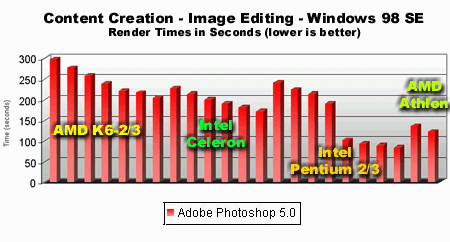Desktop CPU Comparison - September 99
by Anand Lal Shimpi on September 6, 1999 1:23 AM EST- Posted in
- CPUs

What we have here is SSE-overoptimized example number 2, also provided by Intel (not a surprise). The Pentium III naturally takes the incredible lead, but if you ignore those scores an interesting situation emerges. The Athlon is still the fastest processor of the bunch, partly due to the fact that attains the highest clock speed of them all (650MHz). The Intel Celeron is somewhat slower than the Pentium II in the Photoshop tests, with the Pentium II 350 barely pulling ahead of the Celeron at 366MHz and with the only difference between the Pentium II 400 and Celeron 400 being a 5% performance differential.
The benefits of the 25MHz clock increase of the K6-2 475 over the 450 are almost lost to the 5MHz drop in L2 cache frequency (95MHz FSB of the 475 vs 100MHz FSB of the 450) as the 450 is a mere 4 seconds, or about 2%, slower than the K6-2 475. The resulting conclusion here? The K6-2 475 isn't worth any added cost, just like the K6-2 333 wasn't worth the added cost over the K6-2 300. This brings us to a general rule of thumb about processors with L2 caches that scale with processor speed (i.e. Pentium II/Celeron) vs those that remain static (K6/K6-2), if your CPU falls into the first group, then a faster clock speed will yield more benefit than an increased FSB. However, if your CPU falls into the latter group, then clock speed comes second after an increased FSB as is the case with the K6-2.

The AMD supplied LizardTech MrSID Image Compression test is an interesting one, and the results don't boast any outrageous claims such as the Pentium III results from the Intel PhotoDeluxe benchmark from above. The Athlon naturally dominates the benchmark, however for a benchmark supplied by AMD, the Pentium III does come within a decent range of the Athlon's performance. The ranges on the graph are entirely too large to see performance gaps between similar processors, in this case, consulting the table of benchmarks would help quite a bit.
This is one of the cases in which the smaller L2 cache of the Celeron penalizes it as even the 500MHz Celeron has a difficulty keeping up with the Pentium II 350. While the Celeron is still an excellent alternative for gamers, and those that don't do an incredible amount of graphics work, the larger L2 cache of the Pentium II/III does come in handy in certain situations.
In this case, the limiting factor for the K6-2 is the 95/100MHz operating frequency of its L2 cache and not its FPU performance. This can be proven by the dramatic increase in performance the K6-III 450 offers over all of the other K6-X processors by the simple addition of its 256KB of 450MHz L2 cache. The larger L2 cache (in comparison to the Celeron) gives it the edge over even the fastest Celeron in this test and the K6-III 450's performance approaches that of the Pentium III 450, only being slower by around 10 seconds.










0 Comments
View All Comments